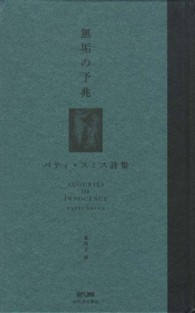基本説明
Presents a survey of those natural and synthetic fragrance and flavor materials which are commercially available, produced and used on a relatively large scale and which are important ingredients for the creation of fragrance and flavor compositions because of their specific sensory characteristics, e.g., smell, taste.
Full Description
Get a good start in flavor and fragrance chemistry! This book presents a survey of those natural and synthetic fragrance and flavor materials which are commercially available, produced and used on a relatively large scale and which are important ingredients for the creation of fragrance and flavor compositions because of their specific sensory characteristics, e.g., smell, taste. It provides information on their properties, methods employed in their manufacture, and their areas of application. This is the 5th edition of the classic "Bauer-Garbe". "...The excellent and concise introduction to this unique industry is followed by extensive information on nearly 500 of the most used fragrance and flavor compounds. Names, molecular formula, physical data, odor and flavor descriptions, uses, and a number of processes for the larger scale production of chemicals are all included. Successive chapters deal with essential oils, animal secretions, quality control, toxicology and literature. The formula, name and CAS registry number index are an invaluable and timely addition." -Parfumer and Flavorist "...Data that would normally have to be selected from many different books are available in one source with this book...with over 800 citations throughout the text, this is a nearly inexhaustible source of information." -Euromaterials
Contents
1. Introduction. 1.1 History. 1.2 Definition. 1.3 Physiological Importance. 1.4 Natural, Nature-identical, and Artificial Products. 1.5 Sensory Properties and Structure. 1.6 Volatility. 1.7 Threshold Concentration. 1.8 Odor Description. 2. Individual Fragrance and Flavor Materials. 2.1 Aliphatic Compounds. 2.1.1 Hydrocarbons. 2.1.2 Alcohols. 2.1.3 Aldehydes and Acetals. 2.1.4 Ketones. 2.1.5 Acids and Esters. 2.1.6 Miscellaneous Compounds. 2.2 Acyclic Terpenes. 2.2.1 Hydrocarbons. 2.2.2 Alcohols. 2.2.3 Aldehydes and Acetals. 2.2.4 Ketones. 2.2.5 Acids and Esters. 2.2.6 Miscellaneous Compounds. 2.3 Cyclic Terpenes. 2.3.1 Hydrocarbons. 2.3.2 Alcohols and Ethers. 2.3.3 Aldehydes and Ketones. 2.3.4 Esters. 2.3.5 Miscellaneous Compounds. 2.4 Other Cycloaliphatic Compounds. 2.4.1 Alcohols and Ethers. 2.4.2 Aldehydes. 2.4.3 Ketones. 2.4.4 Esters. 2.4.5 Miscellaneous Compounds. 2.5 Aromatic Compounds. 2.5.1 Hydrocarbons. 2.5.2 Alcohols and Ethers. 2.5.3 Aldehydes and Acetals. 2.5.4 Ketones. 2.5.5 Esters of Araliphatic Alcohols and Aliphatic Acids. 2.5.6 Aromatic Acids. 2.5.7 Esters Derived from Aromatic and Araliphatic Acids. 2.5.8 Miscellaneous Compounds. 2.6 Phenols and Phenol Derivatives. 2.6.1 Phenols, Phenyl Esters, and Phenyl Ethers. 2.6.2 Phenol Alcohols and their Esters. 2.6.3 Phenol Aldehydes. 2.6.4 Phenol Ketones. 2.6.5 Phenolcarboxylates. 2.7 O-, O,S- and S,S-Heterocycles. 2.7.1 Cyclic Ethers. 2.7.2 Lactones. 2.7.3 Glycidates. 2.7.4 Miscellaneous Compounds. 2.8 N- and N,S-Heterocycles. 3. Natural Raw Materials in the Flavor and Fragrance Industry. 3.1 Introduction. 3.2 Isolation of Natural Fragrance and Flavor Concentrates. 3.2.1 Essential Oils. 3.2.2 Extracts. 3.3 Survey of Natural Raw Materials. 4. Analytical Methods/Quality Control. 5. Safety Evaluation and Legal Aspects. 5.1 Flavoring Substances. 5.2 Fragrance Materials. 6. References. Formula Index: CAS Registry Number Index. Subject index.







